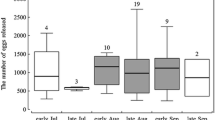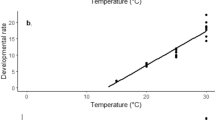Abstract
Egg maturation in Calliphora vicina is known to occur within a wide range of temperatures, from 12°C to nearly 30°C (Vinogradova, 1991). Photoperiodism has no effect on this process. Some females enter diapause already at 20°C; their fraction increases at lower temperatures and reaches 100% at 6°C. Reproducing females with eggs can survive for a long time and even lay eggs at low temperatures (4–5°C). Experiments with C. vicina from Leningrad Province revealed some effects of the diet (liver or fish) and temperature on the fly reproduction. At 20 and 25°C, 7–10-day old females begin to oviposit, but at 20°C egg maturation is observed in 98% of females feeding on liver and in only 5% of females feeding on fish. On the liver diet, the mean daily fecundity is significantly correlated with the day of oviposition but not with the temperature. At 20°C a significant correlation is observed between the mean daily fecundity and both the day of oviposition and food. The total number of eggs laid by flies after feeding on fish is half that produced after feeding on liver. The optimal conditions for Calliphora vicina cultivation are a 16-h light day, temperatures within the range from 20 to 25°C, and liver as food.
Similar content being viewed by others
References
Antonov, S.M. and Magazanik, L.G., “Highly Permeable Contacts Facilitate Efficient Electric Coupling of Insect Muscle Cells,” Biol. Membrany 1(2), 211–213 (1984).
Chernysh, S.I., “On the General Adaptation Syndrome in Insects,” in Mechanisms of Organism Adaptations to Environmental Influence (Leningrad, 1977), pp. 155–156 [in Russian].
Chernysh, S.I., “How to Cure the Incurable?” Sankt-Peterburgskii Universitet, Oct. 31 (2006), pp. 32–37.
Derbeneva-Ukhova, V.P., Flies and Their Epidemiologic Significance (Moscow, 1952) [in Russian].
Kozhanchikov, I.V., “Fecundity and Longevity of Calliphora erythrocephala Mg.,” Doklady Akad. Nauk SSSR 53(4), 385–388 (1946).
Lowne, B.T., The Anatomy, Morphology, Physiology and Development of Blowfly (Calliphora erythrocephala) (London, 1890–1892, 1893–1895).
Marchenko, M.I. and Kononenko, V.I., A Manual of Forensic Entomology (Kharkov, 1991) [in Russian].
Minnich, D.E., “The Culture of Blowflies,” in Culture Methods for Invertebrate Animals (N.Y., 1959), pp. 414–417.
Nachtigall, W., “Calliphora erythrocephala as a Model System for Analyzing Insect Flight,” in Comprehensive Insect Physiology and Pharmacology, Vol. 5 (Oxford, 1984), pp. 571–605.
Saunders, D.S., Kenny, N., and Richard, D.S., “The Blowfly, Calliphora vicina: Some Problems in Photoperiodism and Diapause Endocrinology,” in Endocrinological Frontiers in Physiological Ecology (Wrocaw, 1988), pp. 293–308.
Smith, G.V., A Manual of Forensic Entomology (London, 1986).
Sychevskaya, V.I., “Biology and Ecology of Calliphora vicina R.-D. in Central Asia,” Zool. Zh. 44(1), 552–560 (1965).
Tamarina, N.A., “A Method for Cultivation of the Blowfly Calliphora erythrocephala,” Zool. Zh. 37(6), 946–948 (1958).
Tamarina, N.A., Introduction to Technical Entomology (Moscow, 1990) [in Russian].
Vinogradova, E.B., “The Blowfly Calliphora vicina as a Model Object for Physiological and Ecological Studies,” Trudy Zool. Inst. Akad. Nauk SSSR 118, 1–272 (1984).
Vinogradova, E.B., “Imaginal Diapause of the Blowfly Calliphora vicina R.-D. (Diptera, Calliphoridae) and Its Ecological Control,” Entomol. Obozr. 68(2), 262–271 (1989).
Vinogradova, E.B., “Diapause in Flies and Its Regulation,” Trudy Zool. Inst. Akad. Nauk SSSR 214, 1–255 (1991).
Vinogradova, E.B. and Marchenko, M.I., “Use of Temperature-Related Parameters of Flies in Forensic Research,” Sudebno-Meditsinskaya Ekspertiza, No 1, 16–19 (1984).
Vinogradova, E.B. and Reznik, S.Ya., “Endogenous Changes of the Tendency to Diapause in the Blowfly, Calliphora vicina (Diptera, Calliphoridae),” Proc. Zool. Inst. RAS 281, 151–155 (1999).
Author information
Authors and Affiliations
Additional information
Original Russian Text © E.B. Vinogradova, 2009, published in Entomologicheskoe Obozrenie, 2009, Vol. 88, No. 1, pp. 38–45.
Rights and permissions
About this article
Cite this article
Vinogradova, E.B. Effect of food and temperature on the reproduction of the blowfly, Calliphora vicina R.-D. (Diptera, Calliphoridae), a popular model object in biological research. Entmol. Rev. 89, 137–142 (2009). https://doi.org/10.1134/S001387380902002X
Received:
Published:
Issue Date:
DOI: https://doi.org/10.1134/S001387380902002X




